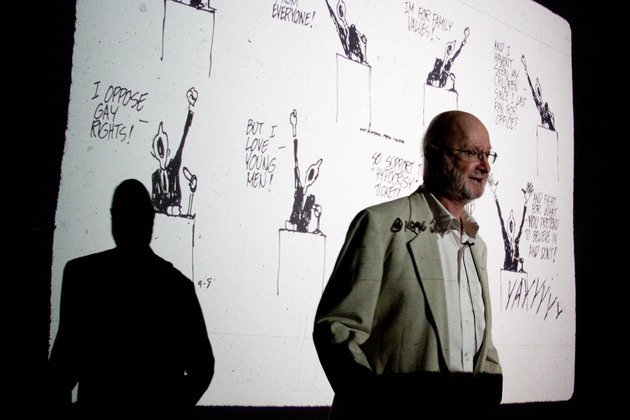Five questions for Jules Feiffer
Jules Feiffer, cartoonist-raconteur born in an era when caricature could be scathing, indicative, deeply personal, and most definitely not post-irony, is the author of Backing into Forward: A Memoir. The cult of Feiffer, which hinges on two of the versatile writer-artist’s best-known personas—illustrator of the beloved children’s book The Phantom Tollbooth and the man behind a much more adult-oriented series of comics, often penned for the Village Voice—revs up in Chicago this weekend in preparation for Feiffer’s conversation with Christopher Borrelli at the Printer’s Row. On the heels of this event, as Feiffer finishes up work on his graphic novel Kill My Mother, our own Miranda Sklaroff asked him a few questions about his process, inspirations, and the decision to make zillions by penning a work of pot-boiled realism:
MS: What made you decide to do an original graphic novel now?
JF: Pure avarice. About a year and a half ago, having made all sorts of changes in my life, I decided it might be a really good idea to make a lot of money fast. Therefore I was going to write a pot-boiler. It was going to be an action thriller, full of all the noir touches that I had grown up reading, adoring in Chandler, Hammett, et. al., and the movie versions thereof. Having written many of the scripts for Will Eisner’s The Spirit from 1949 to 1951, I thought it would be fun to return to an old form, this time strictly in prose, and that I could probably knock it out in a couple of months, sell it for a zillion, not to mention the movie sale, and after that, sit back and relax into my dotage. As it turned out, my pot-boiler never started to even simmer, and in rethinking what I could do about this, and still make zillions, it occurred to me that it might go faster (and be truer to the spirit of Eisner) if I turned it into a graphic novel. But, of course, get someone besides me to illustrate it. Because that sort of realism was not my style. And besides it would take much too much time—a couple of years at least—for me to draw, while there were all these other things that I would much rather do, like lie back and enjoy my dotage.
As it turned out, what I first envisioned as a hack job got more and more interesting, and I became more and more serious about it as I got further and further into the complexities of character and story. And by the time I had finished the first draft of the book that I had named Kill My Mother from the beginning, without a clue as to what the title meant, I had spanned a ten-year period from 1933 and the Great Depression to 1943 and the war in the South Pacific. And I had a cast of characters, larger than life, intricately involved, and most of them women. None of this was planned, it just decided to happen on its own. What happened after that is that WW Norton (and Bob Weil, my editor) loved the manuscript, and took it for granted that, of course, I was going to be the illustrator. I tried to explain to them that I would be 102 before I finished the book, but no one was listening to me, so I went home and started drawing pages that demanded a style that I had serious doubts that I could handle. I had, since early childhood, loved the adventure cartoon—the story strips of Milton Caniff (Terry and the Pirates) and Roy Crane (Wash Tubbs and Captain Easy)—but I opted, when I went professional, for a very different approach and style, partly because I simply, in those years, lacked the sort of craft one needed to execute a good story strip. I’m not all that sorry for what happened to me in the years in between, but now, purely by accident, I have discovered that I can draw in that very style that made me love comics in the first place when I was an aspiring boy cartoonist. So the moral of this little essay disguised as an answer is what goes around, comes around. To which my response is: Whoopee!
MS: Will you focus solely on the novel until you’re done, or will you be working on smaller projects throughout?
JF: While I am at work on the graphic novel, I continue to teach my writing workshop once a week at Stony Brook Southampton, continue to lecture, and draw lots of dancers when the mood strikes me.
MS: Which graphic novelists do you read?
JF: Most recently David Small’s Stitches is the book that most impressed me, but there is a lineup of brilliant work to cite, such as Craig Thompson’s Blankets, whatever Daniel Clowes has turned out this month, and of course, the brilliant continuing work of Chris Ware. And then Alison Bechdel—and whatever my friend Art Spiegelman is up to, I want to know about.
MS: When you work, do the images or the story come first?
JF: Whether doing my strips or writing this novel, it’s first and foremost relationships, out of which grows a story, which I may have the ghost of an idea about at the beginning, but won’t really develop until my characters force it to happen.
MS: You have worked with collaborators often and with great success. What’s it like working with someone else? And on your own? Do you prefer one or the other?
JF: I started out writing and drawing on my own, and that’s the way I have always preferred it, and still do—unless, of course, my oldest daughter Kate come up with an idea, and then our senses of humor are so closely linked that I find it a privilege for me to forget about authorship, and draw her the best book I know how.
